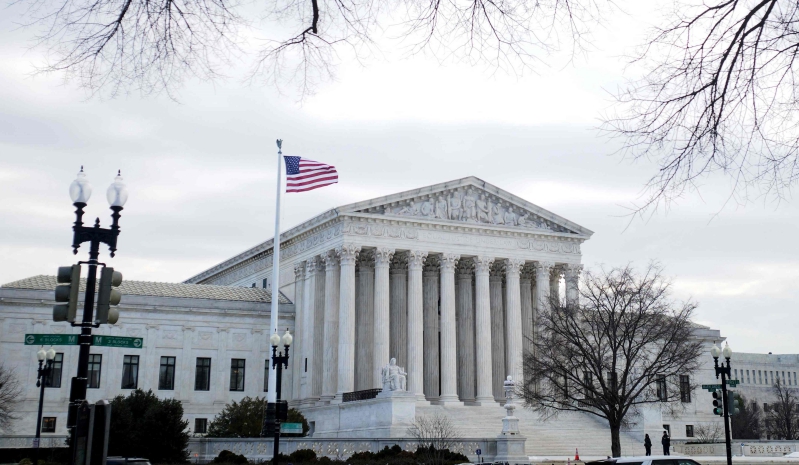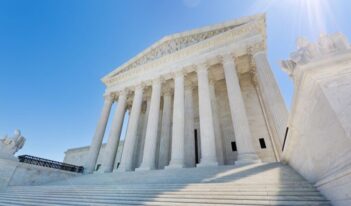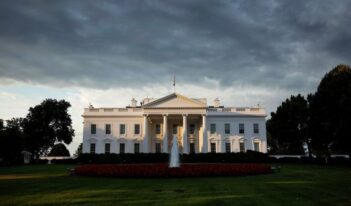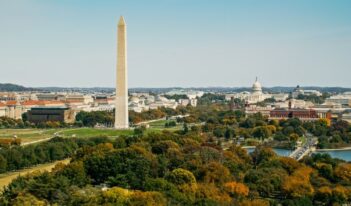
Another regulatory approach to mandate vaccines could have withstood judicial scrutiny.
Earlier this month, a six-justice majority of the U.S. Supreme Court stayed the vaccinate-or-test mandate that the Occupational Safety and Health Administration (OSHA) imposed on employers that have more than 100 employees. On the same day, a five-justice majority refused to stay the mandate that the Centers for Medicare and Medicaid Services (CMS) imposed on organizations that are funded in part by Medicare and Medicaid. As a formal matter, the justices in each case addressed only the question of whether the government was likely to prevail on the merits of each case. But the tone of the opinions strongly suggests that the justices are unlikely to change their views if and when the Court directly addresses the merits of each case.
In both cases, the “major questions” doctrine was critical to the outcome of the case. Under this doctrine, an agency cannot take an unprecedented economically or politically significant action based on an old, broadly worded statute. The agency can only base such a major action on a statute that clearly confers on the agency the power to take the action. The justices who joined the majority opinion in the OSHA case invalidated that agency’s mandate because it violated the major questions doctrine. The CMS mandate survived because two of the justices who joined the majority in the OSHA case concluded that the CMS mandate was similar to prior actions that CMS had taken and that the relevant statute satisfied the clear statement requirement.
The Biden Administration could have taken two other roads that had the potential to produce a better outcome than what the nation is left with after the Supreme Court’s decisions. The most obvious road not taken was to ask Congress to enact a statute that clearly authorizes some federal agency to issue a broadly applicable vaccination mandate. The other road would have been an alternative mandate, one more likely to be upheld by the Supreme Court than OSHA’s.
The decision not to take the legislative road is easy to explain: It would have been an exercise in futility. As I have explained at length elsewhere, extreme and growing political polarity has created a situation in which Congress is totally incapable of enacting a statute in which it clearly addresses any economically or politically significant new problem.
This partisan divide thus creates a situation in which any president who sees a need to take some major action to address a new problem has no choice but to ask agencies to rely on some provision in a statute that is decades old that can plausibly provide the basis for such an action. Any viable statutory candidate will be broadly worded and will have been enacted at a time when Congress was not even aware of the new problem that the country confronts. In many circumstances, no existing statute will satisfy the clear statement requirement that the Court applied in its recent vaccine mandate cases.
This combination of legislative impotence and the major questions doctrine creates a situation in which the U.S. government has no viable means of effectively addressing any new problem that the country encounters. That inability reveals the critical need to begin the extraordinarily difficult process of changing our methods of choosing candidates for the U.S. House of Representatives and the U.S. Senate as well as changing the rules for choosing the leaders of each legislative body. Without major changes in these decision-making processes, Congress will continue to be impotent, and the country will have no viable means of responding to the many new problems of the future.
I identified the second road not taken in the process of teaching administrative law last semester. Every week, I devoted some time to attempts to answer four questions: What is the most promising action the Biden Administration can take to address COVID-19? What actions has the Biden Administration taken to address COVID-19? How are courts likely to respond to the actions the Biden Administration has taken? How have courts reacted to those actions?
It was easy to predict that the OSHA employer mandate would fare poorly in court. OSHA’s prior attempts to regulate health hazards in workplaces have consistently elicited judicial reactions that vary from skeptical to hostile. Before OSHA’s creation in 1970, occupational health was regulated through police power of the states, and the conservative majority on the Supreme Court almost certainly believes that states should continue to take the primary role in regulating occupational health.
Over forty years ago, the statutory authority that OSHA relies on to regulate employee health barely escaped a judicial death sentence. One justice held the statute unconstitutional as a violation of the non-delegation doctrine, and four other justices “saved” the statute from that fate only by attributing to Congress a decisional standard that has no basis in the language of the statute.
OSHA’s recent vaccine mandate had many other problems. The regulated hazard lacked a clear nexus with the workplace. The mandate applied to virtually all workplaces even though workplaces vary greatly with respect to the risk of viral transmission they create. There was no rational basis for the distinction between the workplaces of employers of over 100 employees that were subject to the mandate and the workplaces of employers with fewer than 100 employees who were not subject to the mandate.
There was also a disconnect between the claim of emergency that the President made in September when he announced that the government would issue the workplace vaccine mandate and the claim of emergency that OSHA made two months later when it finally got around to issuing its mandate.
It was also easy to identify an alternative to the employer mandate that would have been much easier to issue, implement, and defend in court. The Transportation Security Administration (TSA) within the U.S. Department of Homeland Security could have issued a mandate applicable to everyone eligible for vaccination as a prerequisite to boarding any plane. TSA has a much better track record in court than OSHA. The health and safety of airline passengers has always been a federal responsibility. A vaccination mandate for passengers would have fit well with the risk of contracting COVID-19 aboard a plane.
Many countries have imposed similar mandates. Travelers have long accepted the need to provide adequate identification as a prerequisite to boarding a plane. They would quickly adjust to the addition of a requirement to produce proof of vaccination.
Because the Biden Administration did not impose a vaccination requirement on airline passengers, it is impossible to know if courts would have upheld such a mandate. But the reaction of the lower courts to the analogous TSA mask mandate strongly suggests that they would. No court has questioned the validity of the TSA mask mandate, and the only circuit court that has even entertained a challenge to the mandate had no difficulty upholding it as a relatively routine exercise of TSA’s undoubted authority to protect the health and safety of airline passengers.
It would also have been easy to identify the need to announce and to implement an air travel vaccination mandate quickly. To accomplish that task, the Administration needed to take two steps as soon as President Biden took office.
First, the Administration should have established a secure online system for determining whether someone has been vaccinated. Such a system would also have the useful side benefit of being able to be used both by agencies at all levels of government and by private parties—such as bars, restaurants, stores, and employers—to implement the vaccine mandates that they impose.
Many countries established systems of that type. The lack of such an easily accessible and retrievable vaccination record system has impeded the U.S. effort to mitigate COVID-19. The paper cards printed by the Centers for Disease Control and Prevention that provide the only record of COVID-19 vaccination are easily lost, damaged, or forged, and they are not accepted as adequate proof of vaccination by many countries.
Second, as soon as President Biden took office, he should have told the TSA to begin drafting an emergency vaccination mandate and the accompanying statement of good cause to justify the implementation of such a mandate without first providing the usual notice and an opportunity to comment on a proposed rule. Instead, what we saw with the OSHA vaccine mandate was a drafting process that undoubtedly caused the unfortunate two-month delay between President Biden’s announcement of an emergency employer mandate and the mandate’s actual issuance.
The first road the Biden Administration chose not to take—asking Congress to enact a statute that clearly empowers the federal government to issue a vaccine mandate—would have been a dead end. The second road the Biden Administration chose not to take—issuance of a vaccine mandate applicable to airline passengers—was a missed opportunity.




